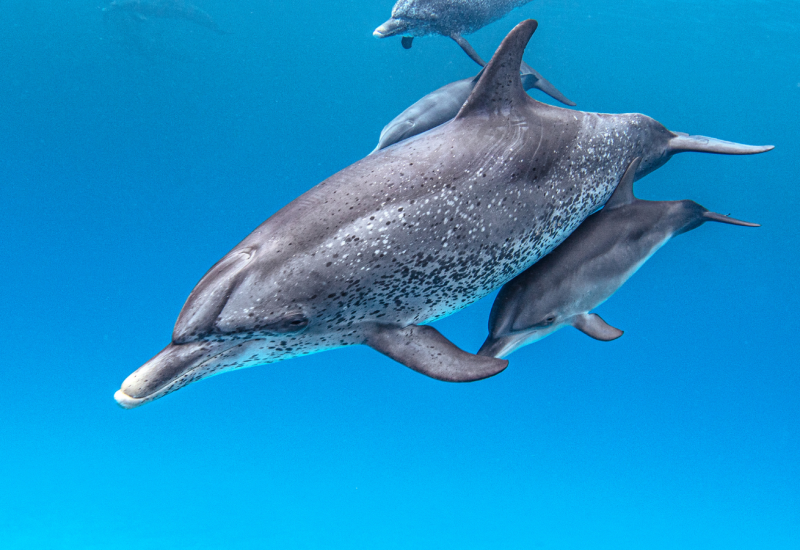Catching Up with the Shark Whisperer: Cristina Zenato
Cool, calm and collected, Cristina Zenato is the picture of serenity before every shark dive. This might be, in part, why so many think of the Women Divers Hall of Fame member as a shark whisperer — she is equally composed in the water working with the Caribbean reef sharks of her home island of Grand Bahama. For the past 17 years, Zenato has been a shark diver and feeder for UNEXSO, introducing newcomers to a shark experience, as well as training the next generation of shark divers.

Cristina Zenato LibraryCristina Zenato was born in Italy and grew up in the African Congo before making the Bahamas her home.
Q: What runs through your mind before every shark dive?
Zenato: No matter how many years I’ve been doing this, I always take a few moments for myself and relax. I take deep breaths. Being relaxed and comfortable is the biggest thing: If you relax your breathing, then you are relaxed underwater. And when you are relaxed, the animals will be relaxed.
Q: You’ve talked in the past about wanting the public’s perception of sharks to shift. Where do you see the most room for change?
Zenato: The first shift that I hope to see is simply with the word “shark.” When we hear the word shark, we visualize — if we are good — maybe eight to 10 kinds of sharks: great hammerhead, bull, tiger, mako, whale shark, etc. But sometimes the first image we visualize is of the jaws of a great white shark. But it’s like hearing the word “bird” and picturing only an eagle. Sharks have the same variety, if not more, as birds. When people hear the word shark, I want them to see endless possibilities.

Ben BuchanZenato gets up close and personal with Caribbean reef sharks off Grand Bahama Island.
Q: You’ve mentioned folks often experience a shift in attitude toward sharks after a dive with you. Has this been your biggest impact on the perception of sharks?
Zenato: Yes and no. Talking with divers, or attendees of Shark Con, is like preaching to the choir. They’re there because they love sharks. I recently had the chance to speak to a random audience of people who were most likely nondivers who had never seen a shark.
Q: Where was this?
Zenato: I was invited to appear on the most watched TV program in China, which airs on one of the country’s main channels on Sunday at 8 p.m. They had me perform a challenge with sharks, and judges determined if I had successfully completed the dare. But the dare wasn’t what was valuable. Rather, the judges, these famous Chinese people, were talking about the necessity of shark conservation and why putting an end to shark-fin soup is so important.
Q: What was the result?
Zenato: It was like a wildfire in terms of the response. I had no idea the impact until the social-media messages flooded in. Viewers said they saw the program, and they thanked me for showing something different. Most didn’t know that shark fin soup was bad for the sharks.
Q: Wow. That’s hard to believe.
Zenato: You don’t know what you don’t know. How many of us consume something that we don’t know what the environmental impact of it is?
Q: I’ve heard you refer to sharks not as apex predators, but as scavengers. Tell me about this word choice.
Zenato: You can’t say, “All sharks do X.” There are around 500 shark species. Just as you couldn’t say all birds nest in trees. Some nest in swamps or mangroves. Similarly, just look at the sizes of sharks. The smallest fits in the palm of your hand, whereas the biggest is the size of a bus. The great white eats seals. A Caribbean reef shark eats fish. Nurse sharks feed on conch and lobster. And the whale shark eats plankton. The whale shark is not an apex predator. That just sounds funny, right?
Q: So what are they?
Zenato: The term apex predator doesn’t always work — it’s limited to only a few species. And where other people see apex predators, I see selective cleaners. Just as lions never attack the healthiest gazelles; they go after the sick ones, the limping ones, the old ones. That’s the role of sharks: selective hunting in the ecosystem in which they are inserted. They keep things balanced and healthy.

Dudley/McLaughlingZenato tapes her hands to prevent the chain mail from sliding.
Why does Zenato wear a shark suit?
When you’re as intimate with sharks as Zenato, you don’t just hop into the water with typical gear. She wears a Neptunic Sharksuit made of a special stainless-steel mesh. Each link is welded and interlocked to increase protection for potential bites. Part of the process includes taping her hands to prevent the chain mail from sliding (right). “It allows me to interact with them at a level I would not be able to without the protection.”










